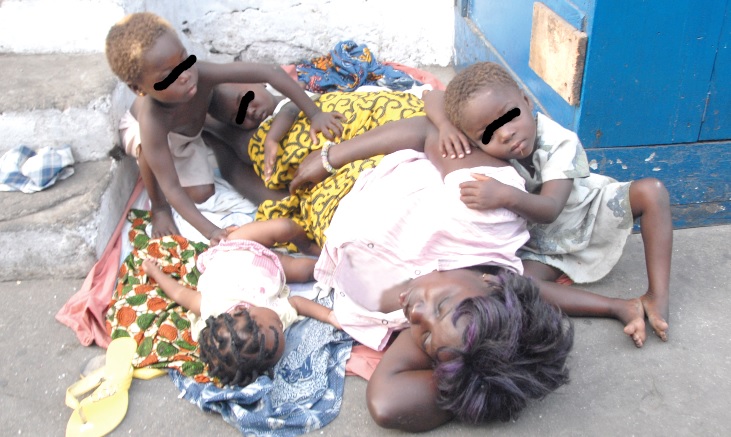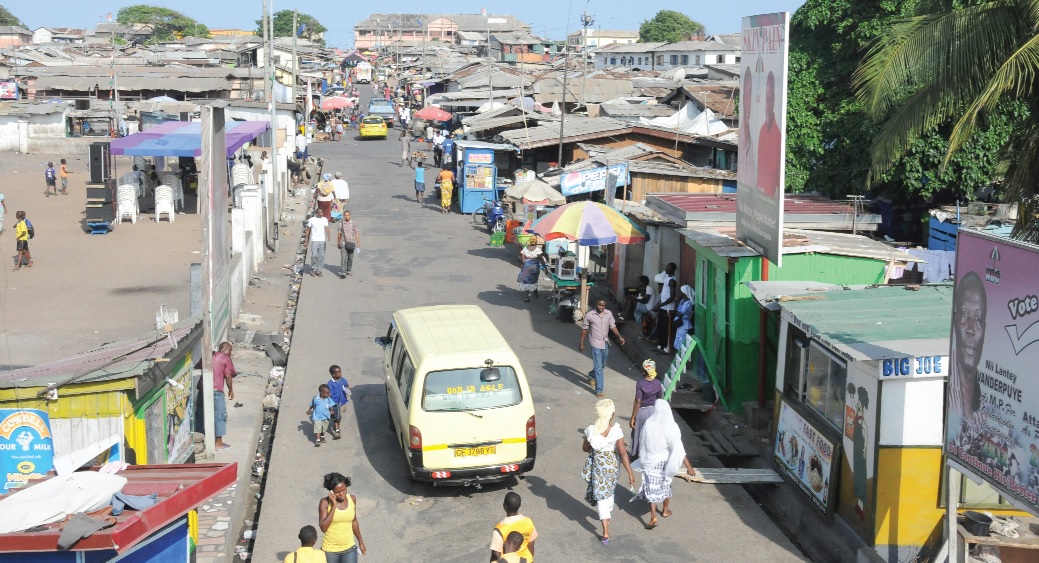A place called Bukom
 Bukom is part of British Accra. It is noted for producing the best boxers for the country, many of whom have won international acclaim. It is a fishing community and its women produce some of the best Ga kenkey or ‘kome’.
Bukom is part of British Accra. It is noted for producing the best boxers for the country, many of whom have won international acclaim. It is a fishing community and its women produce some of the best Ga kenkey or ‘kome’.
Advertisement
Residents of one of the traditional communities in the Ga state come up against the decline in social housing and, therefore, many of them sleep outside.
Most of them do not have rooms, much more beds and pillows.
“Here we don’t sleep because there is nowhere to sleep. Those who want to sleep are at the beach,” one of Ghana’s popular boxers, Braimah Kamoko, aka Bukom Banku, told the Daily Graphic during a night out in the community.
Bukom Banku was born and bred in the community and he was, therefore, emotional while talking about the plight of his people.
Today, it is not only the streets of Bukom that provide shelter for the teeming men, women and children of the area; the James Town Beach has equally become a haven for those who have traded their beds for penury.
According to the boxer, many of the indigenes had fled to the beach to seek refuge, having rented out their rooms to ‘strangers’, a fact which was corroborated by the Director of the Ga Mashie Development Agency (GAMADA), Nii Teiko Tagoe.
The street is my home
It is a vicious circle, rigid to break, subtle but yet easy to comprehend. Auntie Awo (not her real name), a kenkey seller, lives on the Bukom streets with her six children and eight grandchildren.
According to her, she gave birth at the age of 15 and before she clocked 25 she already had three children with two men.
She raised her children, four girls and two boys, single-handedly and in a community where it is difficult to train children. Her first daughter also got pregnant and was delivered of the baby at the age of 15, as if by coincidence.
“I sometimes feel sad, especially when I am alone. I feel sad that I haven’t been able to help my children. I tried to send them to school but it was not easy, as I also had to work and provide them with some of their needs,” she said.
Currently, “all of us live in this small room”, she said as she pointed out the room to me , and added that often the boys slept on the streets because the room was also cluttered with their belongings.
Auntie Awo’s story is perhaps a reflection of the challenges many young girls at Bukom face.
Arguably, about 3,000 people in Ga Mashie, of which Bukom is part, sleep on the streets, according to CHF International, a multinational development organisation. Many, including Bukom Banku, however, believe that the number could be higher during interactions with some of the people themselves.
The NGO’s survey, which took nine months to complete, also established that 48 people lived in a house, with a density of seven people per room.
 “In Ga Mashie, 2,871 people sleep outside, while 14,431 sleep in rooms. For those privileged to be sleeping in rooms, they are cluttered in groups of four and five in dilapidated, leaking, single rooms with broken windows,” it said.
“In Ga Mashie, 2,871 people sleep outside, while 14,431 sleep in rooms. For those privileged to be sleeping in rooms, they are cluttered in groups of four and five in dilapidated, leaking, single rooms with broken windows,” it said.
The situation, according to the report, therefore, reduced Ga Mashie to the status of a slum, as the new United Nations housing standard requires that a maximum of three people live in rooms of 12 square metres.
Ga Mashie, and for that matter Bukom, has, therefore joined the league of slums in Ghana’s capital, Accra, competing with the likes of Sodom and Gomorrah at Old Fadama, and Babylon in the Ministries area.
Meanwhile, the Participatory Slum Upgrading and Preservation Report also indicated that Accra had lost nearly 3,000 hectares of its 17,320 hectares to slums.
The report stated that there were currently about 78 squatter settlements in the city alone and “the Ga Mashie community accommodates six per cent of the slum population in Accra”.
Oldest community in Accra
Advertisement
Bukom Square is agog with the young at heart spending the night away in a frenzy of games, trading, and the list is endless.
Bukom, meaning ‘a well’ is located in Ga Mashie, sited on the Atlantic coast of the Greater Accra Region.
The area is referred to as Old Accra because it is where the original Gas first settled, thereby making it the oldest community in Accra.
According to a consultant on Ga culture, Mr Ebenezer Tetteh-Amay, people from far and near Ga Mashie went to Bukom to fetch water from the ‘Bukomli’, a word which was later adulterated to Bukom.
Advertisement
The well, he said, was, however, closed by the colonial authorities and in its stead the Kinbu (Kin’s well) was dug to provide the water needs of the people of Ga Mashie.
To describe Bukom as congested is a gross disregard for numbers and a lack of appreciation for space.
Drivers can only meander through roads narrowed by the hustle and bustle of the vibrant life of a people whose lives depend on the streets in Ga Mashie.
In one corner, a young boy chats a girl; in another, a fight erupts.
Advertisement
Even at that late hour, a woman washes her clothes by the gutter, and going further, yet another woman takes a bath, right on the street, and all appear normal, at least for those who call Bukom their home.
Plight of a community that once thrived
Bukom’s present condition can be traced to many factors, including the 1939 earthquake which brought down most of the double storey buildings in the community and left many people homeless.
Mr Amartey, who now lives at James Town, recounted what he heard as a boy many years ago.
According to him, the spread of the bubonic plague in 1908 left in its trail such devastation which compelled the colonial authorities to indiscriminately demolish many houses.
The bubonic plague was a disease which killed many Gas in the then Gold Coast.
The earthquake of 1939 was another significant occurrence from which Ga Mashie suffered immense damage and in response to which most of the elites then living in the area moved out to the then developing residential areas in the north of the city. This, according to Mr Amartey, led to a detrimental outflow of wealth from the community.
The last straw that broke the camel’s back was the relocation of the harbour, which offered enormous job opportunities to the people, to Tema in 1962.
These factors, coupled with the lack of education, crippled and stifled the development of Ga Mashie till date.
“With this move, we lost a strategic source of economic activity. Since then, the collapse of the local economy has been irreversible, with disastrous effects on the community,” Mr Amartey stated.
Today, able-bodied men only play ludo, draught and soccer at a time when their energies could be channelled into productive profit oriented ventures, he said.
The result is the poverty that stare the people in the face and hinders progressive moves from all, including the city authority, the Accra Metropolitan Assembly (AMA).
Way Forward
Housing is a major issue affecting the living conditions of the people of Bukom.
According to the Participatory Slum Upgrading and Prevention Report, “to address the current issue of overcrowding in Ga Mashie, the community will need 33,447 sleeping rooms (standard 12 square metres) to bring current room occupancy to three persons”.
“In the next eight years, this should be seriously considered in any housing upgrading for the community,” it recommended.
Transforming Bukom has been at the heart of many, including the Director of GAMADA, Mr Tagoe, who, at the moment, appears to be running a lone office.
GAMADA was established following a memorandum of understanding (MoU) signed between the AMA and the city of Amsterdam with a view to improving on the living condition of the people of Ga Mashie in the areas of education, local economic development, tourism development and housing.
By the signing of the MoU, GAMADA is required to execute the 2015 Old Accra Development Strategies developed by UNESCO.
According to Mr Tagoe, the UNDP tasked UNESCO to carry out a research and come up with strategies that would propel Ga Mashie on to development.
Those strategies were to be implemented as a national programme and so it was handled by the Ministry of Local Government and Rural Development in 2000, but it stalled shortly after.
GAMADA was, therefore, established to implement the findings of UNESCO, but in the words of Mr Tagoe, “not much has been achieved since the last six years that the agency was established”.
The agency, meanwhile, has just two years to make some real impact on the lives of the people of Ga Mashie.
Mr Tagoe, full of optimism in a new housing project being designed by KPF, an international architectural firm, in partnership with the Millennium Challenge Initiative (MCI) and the Ga Mashie Advisory Committee, said a lot could be achieved within the two years, if the people supported the efforts with their hearts.
By Naa Lamiley Bentil/Ghana




